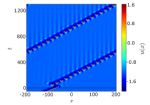EPJ B Highlight - Taming neural excitations
- Details
- Published on 25 November 2014

A theoretical study of short- and long-range effects on neural excitation pulses might one day lead to controlling harmful signals such as those in strokes
What do lasers, neural networks, and spreading epidemics have in common? They share a most basic feature whereby an initial pulse can propagate through a medium—be it physical, biological or socio-economic, respectively. The challenge is to gain a better understanding—and eventually control—of such systems, allowing them to be applied, for instance to real neural systems. This is the objective of a new theoretical study published in EPJ B by Clemens Bachmair and Eckehard Schöll from the Berlin University of Technology in Germany. Ultimately, with a better theoretical understanding, scientists aim to control such excitations in networks of neurons to prevent their detrimental effects like in stroke.
Scientists have long sought to find a means of controlling the excitation pulses in what are referred to as excitable media—either to suppress or to accelerate them. Or even to generate completely new spatio-temporal patterns that alter the impact of the pulses on their surroundings.
This time, the German team has performed the first systematic theoretical analysis of the influence of a specific kind of spatial interaction on the propagation of excitation pulses. Specifically, they focused on a kind of interaction that is attractive for small distances and repulsive for large distances. This characteristic mirrors interacting neurons in the cortex. Indeed, they combine excitatory coupling of neighbouring cells with long-range interactions of distant cells inhibiting the electric pulse propagation, previously demonstrated by neuroscientists.
In this study, the authors found, for the first time, that such non-local couplings can produce a rich variety of spatio-temporal patterns. These include acceleration, deceleration, and suppression of propagating pulses, and multiple pulses and blinking traveling waves. They also show that the response all depends on the type of parameters in the short- and long-range coupling.
C. Bachmair and E. Schöll (2014), Nonlocal control of pulse propagation in excitable media, European Physical Journal B, DOI: 10.1140/epjb/e2014-50339-2




